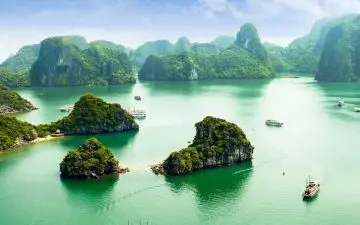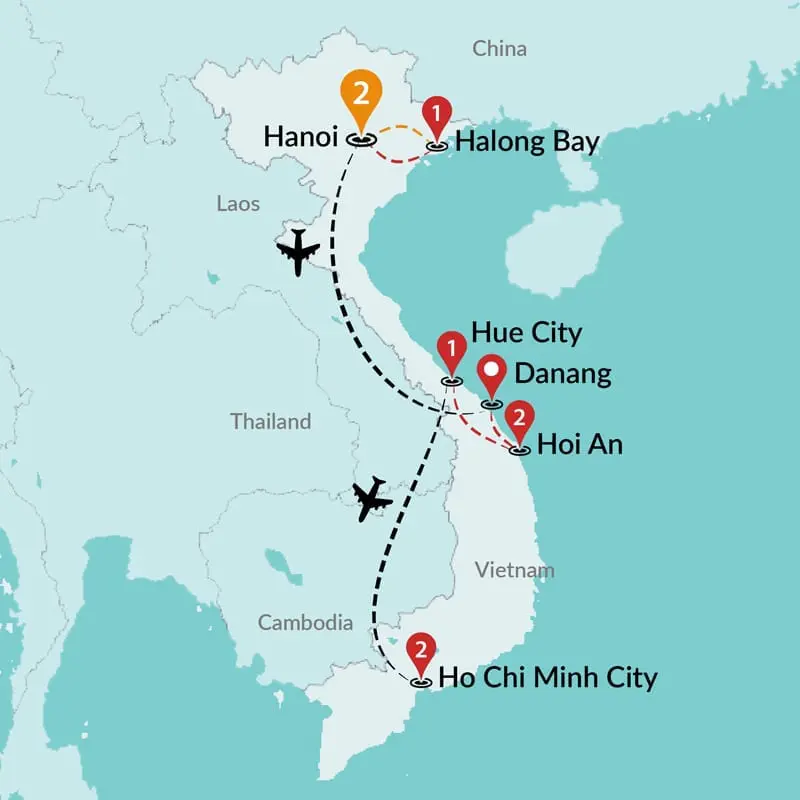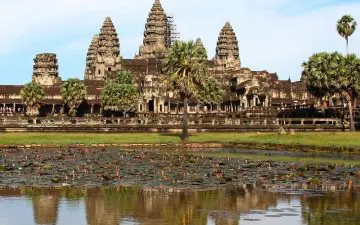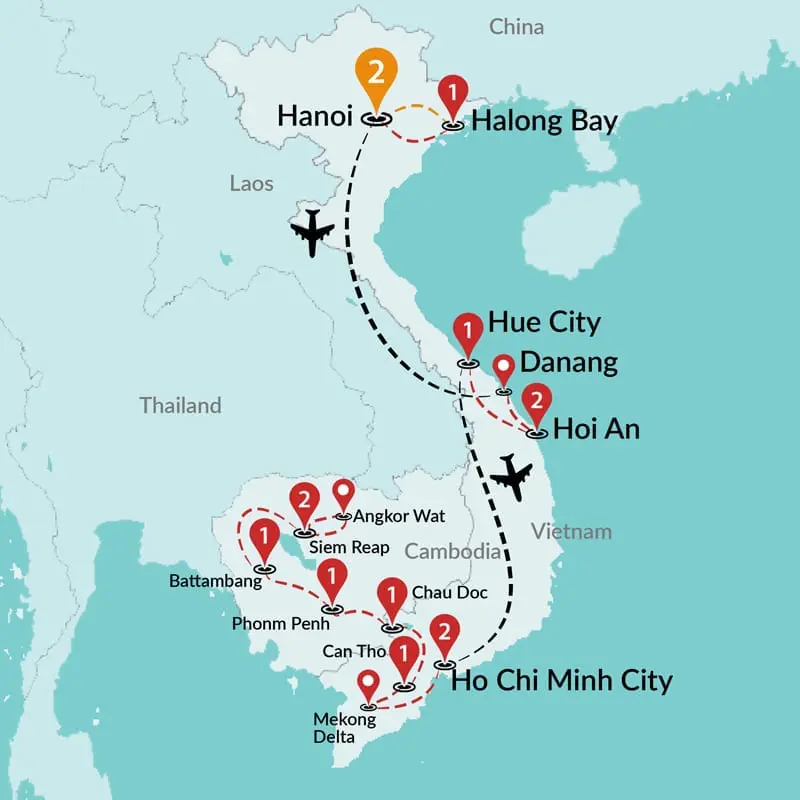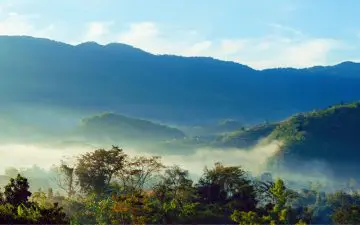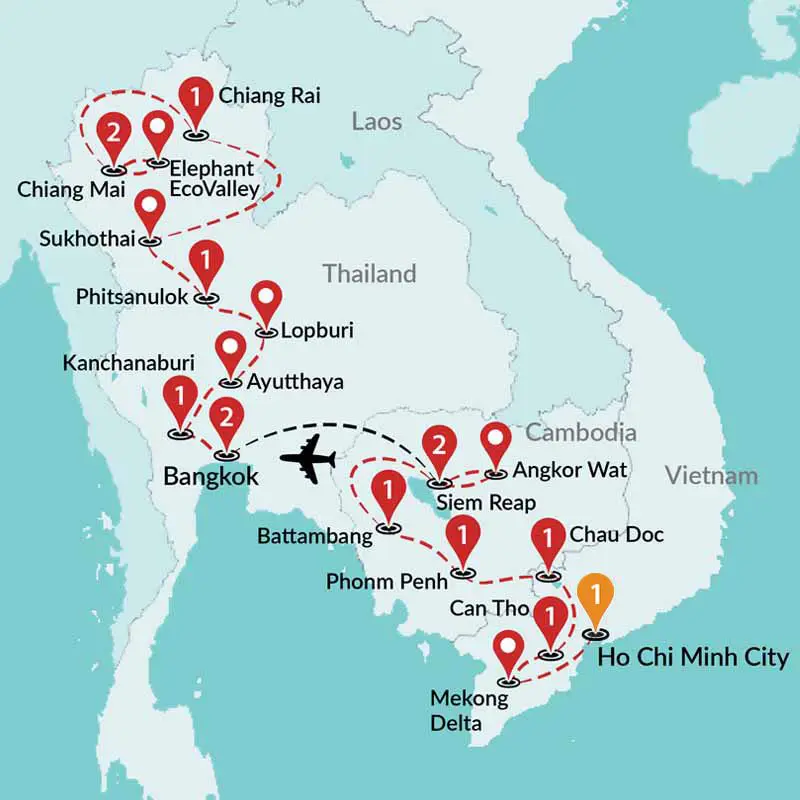Best Time To Visit Vietnam
The best time to visit Vietnam is between November and April, when the country’s south, central, and north regions experience dry and mild weather. The three main regions of Vietnam are quite different in terms of their climate, making Vietnam a year-round destination.
Northern Vietnam experiences its dry season between November and April. The weather is pleasant throughout fall and spring, and temperatures drop below 20°C in January and February. From May to October, it is comfortably warm, but high humidity results in frequent rain showers.
Central Vietnam has dry and hot weather from January to August, making it the peak season for coastal cities. Between September and December, the central coast experiences the typhoon season with heavy rainfall. However, temperatures are still balmy and ideal for visiting. Southern Vietnam shares the same pattern with the northern region, but winter temperatures are much higher. The weather is perfect for visiting all year round.
Why You Should Visit Vietnam: Vietnam is a Southeast Asian gem that offers a perfect blend of stunning natural landscapes, rich history, and diverse culture. From the lush rice paddies of Sapa to the iconic limestone pillars of Halong Bay, Vietnam’s natural beauty is awe-inspiring. The country’s turbulent past is palpable in its historic cities, such as Hanoi and Ho Chi Minh City, where visitors can explore the many museums and monuments dedicated to the Vietnam War. With friendly locals, affordable prices, and a plethora of experiences to choose from, Vietnam is an ideal destination for travelers seeking an unforgettable adventure.
Things to Consider: Vietnam is a tropical country, so it’s essential to pack light and breathable clothing. It’s important to plan your itinerary carefully to make the most of your time in Vietnam, whether you’re interested in exploring the bustling cities, relaxing on the beaches, or visiting historical landmarks. Be respectful of the local customs and traditions, and try to learn a few basic phrases in Vietnamese to connect with the friendly locals.
Monthly Travel Guide For Vietnam
Travelling in Vietnam in February
The weather continues to be dry and warm in the southern and central regions, while mornings in the north experience long hours of sunshine. The historic sites of Central Vietnam are perfect for exploring with walking tours in February.
The festive cheer of the Lunar New Year continues in the first week of the month. However, some restaurants and shops may be closed during the holidays.

Vietnam Climate & Weather Guide
| Region | Jan | Feb | Mar | Apr | May | Jun | Jul | Aug | Sep | Oct | Nov | Dec |
|---|---|---|---|---|---|---|---|---|---|---|---|---|
| Hanoi | 19°C | 20°C | 23°C | 27°C | 32°C | 33°C | 33°C | 32°C | 31°C | 28°C | 25°C | 21°C |
| Danang | 24°C | 25°C | 27°C | 29°C | 31°C | 32°C | 32°C | 32°C | 31°C | 28°C | 26°C | 23°C |
| Hoi An | 24°C | 25°C | 28°C | 30°C | 32°C | 32°C | 33°C | 33°C | 31°C | 29°C | 27°C | 25°C |
| Hue City | 23°C | 24°C | 27°C | 30°C | 33°C | 34°C | 34°C | 34°C | 31°C | 28°C | 26°C | 23°C |
| Ho Chi Minh City | 31°C | 32°C | 33°C | 33°C | 33°C | 31°C | 31°C | 31°C | 31°C | 30°C | 30°C | 30°C |
| Halong Bay | 19°C | 20°C | 23°C | 27°C | 31°C | 32°C | 33°C | 32°C | 31°C | 28°C | 25°C | 22°C |
| Sa Pa | 20°C | 22°C | 26°C | 30°C | 32°C | 32°C | 32°C | 32°C | 31°C | 28°C | 24°C | 21°C |
When to visit Vietnam
Trips to Vietnam All Year Round
Since the three primary regions of the country experience different weather conditions in the same period, Vietnam has something to offer every season. The spring and fall months offer the optimal weather for hiking in Sapa and Hanoi. Visiting the villages and towns are the highlight activities of the dry season. The blooming nature and busy local life provide a unique experience in the northern countryside in these seasons. The weather is clear in Halong Bay, making it the best time to enjoy the islands and natural wonders as you cruise on a traditional Junk Boat.
June to August is the best time to visit Vietnam for enjoying a cultural trip in the port cities. The riverside town of Hoi An offers leisure time in the quiet low season, and the balmy temperatures make it a popular time for visiting the beaches. In winter, the entire country enjoys plenty of sunshine. It is the best season for admiring the beautiful architecture of imperial Vietnam in the south and witnessing spectacular views of the picturesque landscape. Our Ultimate Vietnam trip includes the must-see attractions across Southern, Central, and Northern Vietnam, which are perfect for exploring all year round.
Best things to do in Vietnam:
– Cruise Halong Bay: Halong Bay is a UNESCO World Heritage Site and one of the most beautiful natural wonders of Vietnam..
– Vietnam is known for its lush green rice paddies, especially in the north around Sapa and the Mekong Delta in the south.
– The Vietnam War is an important part of the country’s history, and you can learn about it at various museums and historical sites, including the Cu Chi Tunnels.
– Try the street food: You can explore the street food scene in Hanoi’s Old Quarter or Ho Chi Minh City’s District 1.
Visit Vietnam & Thailand between November and April
From November to April, you can embark on a journey to experience South-East Asia’s cultural heritage in Vietnam and Thailand. As the countries experience dry and pleasant weather throughout the season, traveling in the countryside and sightseeing in the cities offer a joyous vacation. It is the best time to visit Vietnam and Thailand with a combined trip.
From iconic islands and intricate cave systems of Halong Bay to the lush tea plantations of Thailand’s Ching Rai, nature has a lot to offer across the land. Our Incredible Vietnam & Thailand ends Bangkok trip takes you to the most intriguing countries of South-East Asia for a blend of old and new.
Tips for visiting Vietnam and Thailand from November to April:
– The weather in Vietnam and Thailand during this time can vary, so it’s important to pack clothing for both warm and cool weather.
– It is peak tourist season in both Vietnam and Thailand, so expect larger crowds and higher prices.
– Both Vietnam and Thailand can be quite hot and humid, so make sure to drink plenty of water and stay hydrated.
– Don’t be afraid to try some of the local specialties. Just be sure to choose vendors with good hygiene practices.
– Both Vietnam and Thailand are predominantly Buddhist countries, so it’s important to be respectful of local customs and traditions.
The Ultimate South-East Asia Experience
Vietnam, Cambodia, and Thailand are the gems of South-East Asia’s cultural and natural heritage, from majestic hillside monasteries to exciting urban centers, colorful floating markets, and villages to lush national parks. A trip through these rich countries offers insight into some of history’s most famous empires and civilizations while taking you on an adventure in the fascinating nature blessed by the monsoon climate.
From November to April, the vast land experiences perfect weather, making it an ideal time for exploring the heartlands of the countries. The monsoon season from May to October is also a rewarding time, as the forests and fields stretching across the continent are in full bloom. Our Vietnam & Cambodia & Thailand ends Bangkok trip offers the ultimate experience across the iconic countries of South-East Asia all year round.
Why you should book a trip to Southeast Asia:
– Stunning natural beauty: Southeast Asia is home to some of the world’s most beautiful natural landscapes, from the lush rice paddies of Vietnam to the pristine beaches of Thailand
– Fascinating culture and history: Home to influences from Buddhism, Hinduism, Islam, and other religions. You can explore ancient temples, pagodas, and historical sites.
– Warm and welcoming people: Southeast Asians are known for their hospitality, warmth, and friendliness towards travelers.
– Delicious cuisine: Southeast Asian cuisine is renowned for its bold flavors, fresh ingredients, and diverse influences.
Vietnam FAQ
What’s the best time to visit Vietnam for budget travellers?
The best time to visit Vietnam for budget travellers would be during the low season, which is from May to September. During this time, you can find cheaper airfare and hotel rates, as well as discounts on tours and activities. Additionally, there are fewer crowds during this time, which can make for a more peaceful and relaxed travel experience.
However, it’s important to keep in mind that the weather can be unpredictable during the low season, with heavy rains and occasional typhoons. It’s also worth noting that some tourist attractions may have reduced hours or be closed during this time.
What is the rainiest month in Vietnam?
The rainiest month in Vietnam depends on the region. Generally, the rainy season in Vietnam is from May to October, with September and October being the wettest months. However, the amount of rainfall can vary significantly depending on the region. For example, in northern Vietnam, the rainy season starts in May and ends in August, with July and August being the wettest months.
When is the best time to visit Vietnam for trekking?
The best time to go trekking in Vietnam varies depending on the specific region you plan to visit. In general, the most popular trekking areas in Vietnam, such as Sapa and Ha Giang in the north, have the best conditions for trekking from September to November and from March to May. During these months, the weather is cooler and drier, and the rice terraces are usually at their greenest.
When is the best time to visit Vietnam to avoid the crowds?
The best time to visit Vietnam to avoid crowds is generally during the shoulder seasons, which are from April to June and from September to November. During these months, the weather is generally good, and there are fewer tourists than during the peak season.
However, it is important to note that some popular tourist destinations, such as Halong Bay and Sapa, may still be crowded during these times. It’s also worth considering visiting some of the lesser-known destinations in Vietnam, which are typically less crowded year-round.
When is the best time to visit Vietnam for cultural events?
Vietnam has a rich cultural heritage and hosts many festivals throughout the year. Some of the most popular festivals and events in Vietnam include Tet Lunar New Year, Hue Festival, Mid-Autumn Festival, and the Hoi An Lantern Festival.
Tet Lunar New Year is one of the biggest and most important cultural events in Vietnam, usually taking place in late January or early February. This festival marks the beginning of the lunar new year and is celebrated with family gatherings, fireworks, and traditional foods.
When is the typhoon season in Vietnam?
The typhoon season in Vietnam typically runs from May to November, with the highest frequency of typhoons occurring from July to September. It is important to note that typhoons can cause disruptions to travel plans and outdoor activities during this time, particularly in coastal regions. Travelers should monitor weather forecasts and heed any warnings or advisories issued by local authorities.
How many days do you need to visit Vietnam?
The duration of a trip to Vietnam depends on the specific interests and preferences of each traveler. However, to explore some of the highlights of the country, a minimum of 7-10 days is recommended. This allows time to visit popular destinations such as Hanoi, Halong Bay, Hoi An, and Ho Chi Minh City.
What is the coldest month in Vietnam?
Vietnam is a long and narrow country with a varied climate, so the coldest month depends on the region you are in. In the northern part of Vietnam, including Hanoi, the coldest month is typically January, with average temperatures ranging from 15-20°C (59-68°F). In the central region, including Hue and Da Nang, the coldest month is usually December, with average temperatures ranging from 18-23°C (64-73°F).
What are the best cities to visit in Vietnam?
Hanoi: The capital city of Vietnam is known for its charming Old Quarter, French colonial architecture, and rich history. Ho Chi Minh City: Formerly known as Saigon, this bustling metropolis in the south of Vietnam is famous for its street food, markets, and historical landmarks such as the Cu Chi Tunnels. Hoi An: This UNESCO World Heritage Site is a picturesque town with ancient temples, colorful lanterns, and traditional architecture. Hue: Another UNESCO World Heritage Site, Hue is famous for its Imperial City and royal tombs, which offer a glimpse into Vietnam’s history.
Is it safe to travel to Vietnam?
In general, Vietnam is considered a safe country for travellers. The country has a low crime rate, and incidents of violence against foreigners are rare. However, like any country, there are still risks to be aware of such as pickpocketing and scams. You should take standard precautions such as being aware of your surroundings, avoiding carrying large sums of money, and securing your belongings when traveling.
What are the most beautiful places in Vietnam?
Ha Long Bay: Located in the northeast region of Vietnam, Ha Long Bay is one of the country’s most iconic natural attractions. Hoi An: This charming town on the central coast of Vietnam is known for its well-preserved ancient buildings, colorful lanterns, and winding canals. Sa Pa: Located in the northwest region of Vietnam, Sa Pa is a picturesque mountain town surrounded by terraced rice fields and rolling hills. Hue: This former imperial capital of Vietnam is known for its rich history and architecture.
Does Vietnam have nightlife?
Vietnam does have nightlife, especially in its major cities such as Hanoi, Ho Chi Minh City, Da Nang, and Nha Trang. In Hanoi, for example, there are many bars, clubs, and music venues that cater to both locals and tourists. The Old Quarter and the area around Hoan Kiem Lake are particularly popular for nightlife, with many bars and clubs offering live music, DJ sets, and cheap drinks.
Which airlines fly directly into Vietnam?
There are several airlines that operate direct flights to Vietnam, including: Vietnam Airlines, VietJet Air, Bamboo Airways, Korean Air, Asiana Airlines, Cathay Pacific Airways, Japan Airlines, Emirates, Turkish Airlines, Air France.
What to wear in Vietnam?
Choose lightweight, breathable clothing made of natural fabrics like cotton, linen, or rayon. Avoid synthetic materials that can trap heat and moisture. Wear a hat or a cap to protect your face from the sun, and use sunscreen to avoid sunburn. Dress modestly, especially when visiting temples or other religious sites. Cover your shoulders and legs, and avoid revealing clothing. Although the temperature is generally warm, it can get chilly at night or in the mountains. Bring a light jacket or sweater to layer over your clothes.
What is Vietnam famous for?
Vietnamese food is known for its fresh ingredients, bold flavors, and healthy cooking methods. Some popular dishes include pho (noodle soup), banh mi (baguette sandwiches), and spring rolls. Ha Long Bay: This UNESCO World Heritage Site is a stunning collection of more than 1,600 limestone islands and islets in the Gulf of Tonkin. Historical landmarks: Vietnam has a rich history, and there are many historical landmarks to explore, such as the ancient city of Hoi An. Vietnam is the second-largest coffee producer in the world, and its coffee is famous for its unique flavor and strong, sweet taste.
What is the best time to eat delicious food in Vietnam?
Tet, the Vietnamese Lunar New Year, usually falls in late January or early February. This is a time when many families gather to prepare and enjoy traditional dishes like banh chung (sticky rice cake with pork and mung beans), nem (spring rolls), and thit kho (caramelized pork). In the hot summer months, refreshing dishes like goi cuon (fresh spring rolls), bun cha (grilled pork with rice noodles), and banh mi (Vietnamese sandwich) are especially popular.
Do you need a visa to visit Vietnam?
It depends on your nationality and the purpose and duration of your visit to Vietnam.
Citizens of some countries may enter Vietnam for a certain period of time without a visa, while others may require a visa in advance or obtain a visa on arrival. You can check the visa requirements for your specific situation on the official website of the Vietnam Immigration Department or contact the nearest Vietnamese embassy or consulate in your country for more information.
Vietnam by Season

Winter
Tet, or the Vietnamese Lunar New Year, is the biggest festival in Vietnam and is celebrated in late January or early February. During this time, flower markets pop up throughout the country, selling colorful flowers such as peach blossoms and kumquat trees.
Best time to enjoy the festive spirit in Vietnam through cultural excursions.
Best Things to do in Vietnam in winter:
Attend the Hue Festival. Take a tour of the coffee plantations, learn about the coffee-making process

Spring
A great time to explore the country’s stunning landscapes, ancient temples, and vibrant culture.
You can take a cruise in Halong Bay to explore the limestone karsts, hidden lagoons, and floating villages. Spring is a great time to visit as the weather is mild and the crowds are smaller. Take a bike tour of the Mekong Delta and admire the ice paddies, floating markets, and idyllic villages.
Best Things to do in Vietnam in spring:
Explore the ancient city of Hoi An. Take a cooking class to learn about local cuisine, or shop for unique handicrafts in the many artisan shops in Vietnam.

Summer
Take a guided tour to explore the rice terraces in Sapa, hike to remote villages, and learn about the local culture and way of life.
Ho Chi Minh City is Vietnam’s largest city and is known for its vibrant street food culture. You can take a food tour to sample local delicacies, from pho to banh mi to fresh seafood.
Best Things to do in Vietnam in summer:
Attend the Hoi An Lantern Festival. The festival features colorful lanterns, traditional music and dance performances, and a magical atmosphere that is not to be missed.

Autumn
The Mekong Delta is a lush, fertile region in southern Vietnam known for its floating markets, where vendors sell fruits, vegetables, and other goods from their boats. You can take a boat tour to explore the markets and learn about the local way of life.
Visiting the Imperial City of Hue can also prove to be a unique experience in the lush landscape of fall season in Vietnam.
Best Things to do in Vietnam in autumn:
Enjoy colorful lanterns, traditional music and dance performances, and mooncakes in the Mid-Autumn Festival.
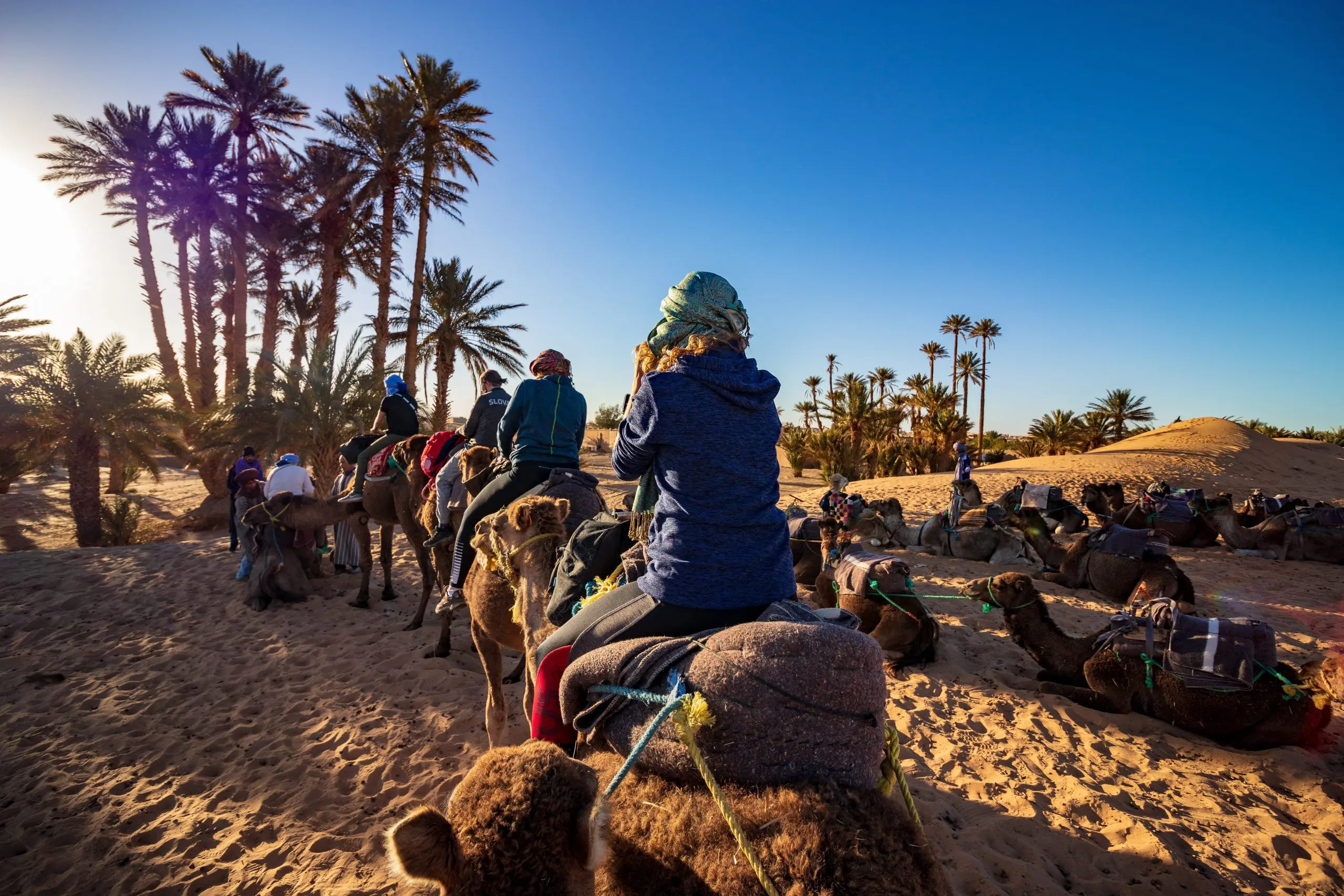 February Sale; 2 For 1
February Sale; 2 For 1  Croatia Sailing : 2 For 1
Croatia Sailing : 2 For 1 Asia Tours : 2 For 1
Asia Tours : 2 For 1 Central & Eastern Europe Tours: 2 For 1
Central & Eastern Europe Tours: 2 For 1 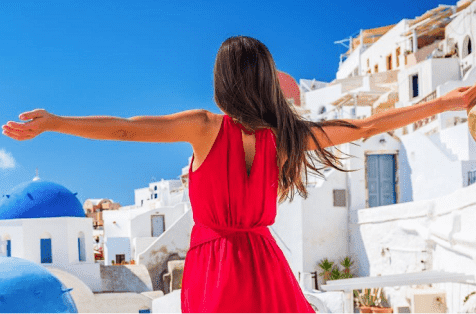 Why Travel Talk
Why Travel Talk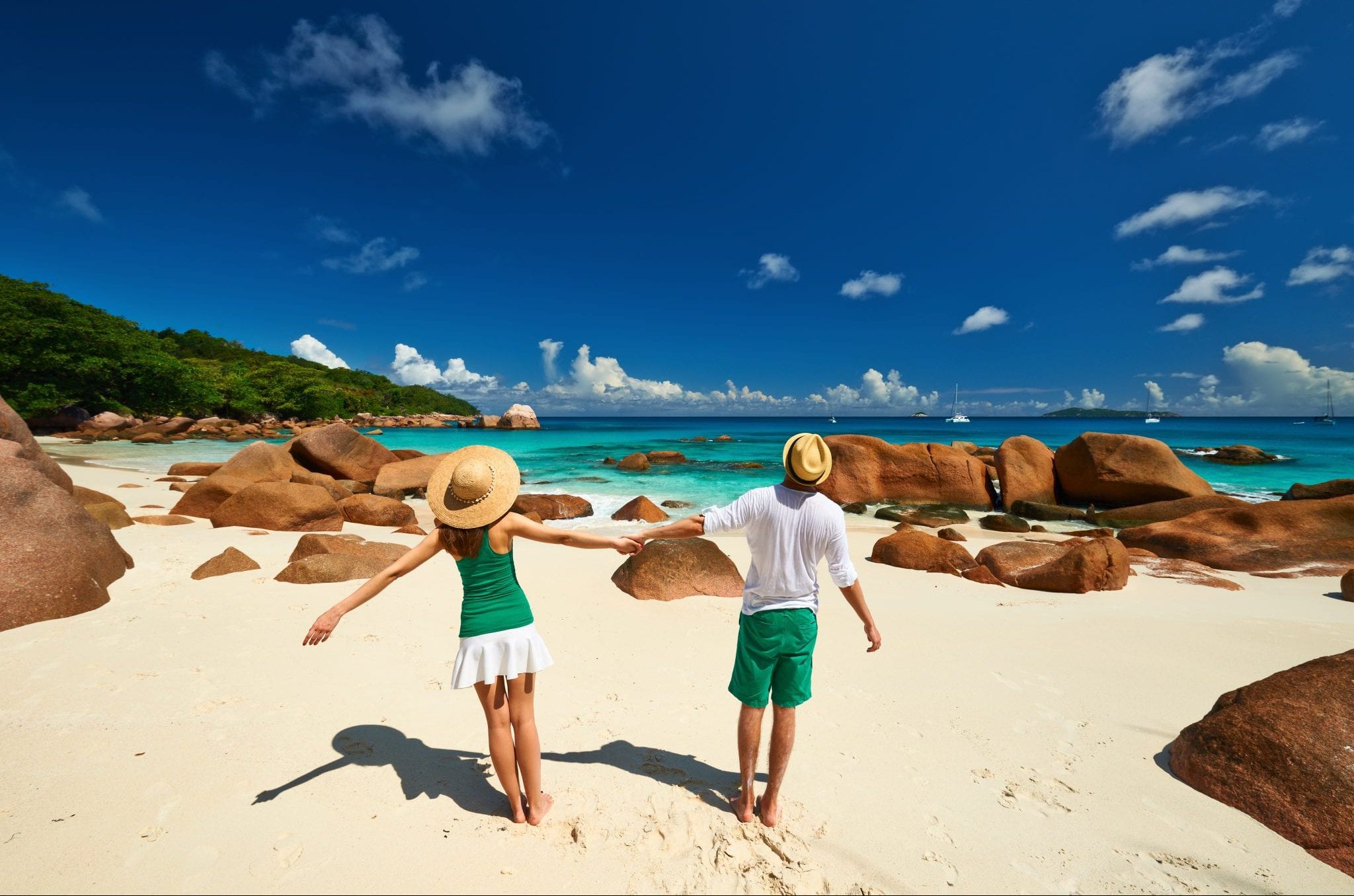 Travel Talk Blog
Travel Talk Blog Responsible Travel
Responsible Travel Fair Travels with Travel Talk
Fair Travels with Travel Talk







